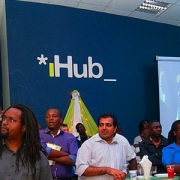Somali at Dadaab Camp text UN aid tip…
Responding to the food security needs of those affected by famine in the Horn of Africa is an enormous logistical challenge…
The most severe drought in a half a decade has made the already unstable region, particularly Somalia, an even more food insecure place. The United Nations is on the cusp of declaring a full-blown famine in Somalia, having deemed nearly a third of the country’s regions (5 of 18) to be experiencing a famine, which means more than 30% of people in those areas are subject to malnutrition—a quarter of all Somalis can relate. Upwards of 12 million people are caught in this perilous situation that also found toeholds in sections of Dijibouti, Ethiopia and Kenya.
The food crisis (and all out famine in parts) is made worse by drought, but high fuel and food prices, and longstanding conflict in the region are primary causes. This makes for an especially complex emergency, where getting the right kinds of aid to people when and where they need it most, logistics, requires smart tools and strategies. This gives credence to the rapid shift in how development aid is being managed and deployed, to a point where technology becomes a vital tool in emergence response.
The ongoing crisis in the Horn of Africa underscores this. The last issue of The Economist carried an article with an insightful lead that quotes a text message from a Somali affected by famine. The sender declared ‘“MY NAME is Mohammed Sokor, writing to you from Dagahaley refugee camp in Dadaab. Dear Sir, there is an alarming issue here. People are given too few kilograms of food. You must help.” Mr. Sokor texted his appeal to two United Nations officials, in London and Nairobi, after finding their numbers on the internet while surfing at a café at the north Kenyan camp.
As many have observed, Mr. Sakor’s strategic use of a near ubiquitous ICT, his mobile-phone, signals the rapidly transforming relationship between the senders and receivers of aid. It is clear that greater accountability and agility will become a demand from the bottom-up. Increasingly, aid recipients will influence the kinds of aid they receive, where and how they get it. “In the humanitarian operation of the future,” says Save the Children’s Mr Porter, “beneficiaries of emergency aid will use technology to tell us what they need—cash, food, or education—find out from us what to expect, and track its arrival, just as we can track an order from Amazon.com now.”
But, the relationship between food security and logistics supersedes complex humanitarian scenarios. As I contend in a previous blog, food insecurity is caused by a wide range of factors, including declining yields, inadequate investment in research and infrastructure, and increased water scarcity, but it is also brought about by immense waste. Logistical woes is a key cause for much of this waste. For instance, more than a third of crops reaped never gets to market in edible fashion because of poor value chain management and practices.
Long term development of the agricultural systems in the region must focus on using logistics technology to improve transportation and warehousing of produce. It’s crucial that we reduce food waste in the drive to improve food security.






































